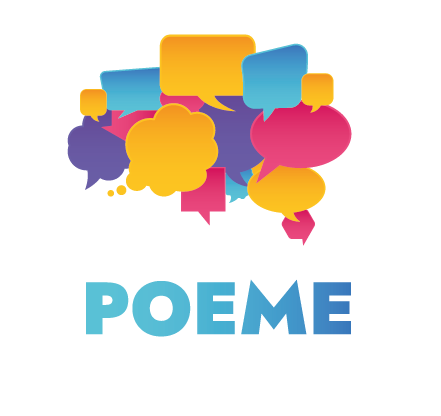POEME project offers opportunities to migrant and local learners to co-create and curate exhibitions. But how important, exactly, is their contribution in this manner?
In fact, the curation process offers multiple and diverse benefits to anyone who engages with it which further highlight the pedagogical use of exhibitions for learning in general, but also for language learning and integration in particular. Distinguishing the benefits of physical and digital exhibitions is also useful in deciding which type of learning exhibition will be useful depending on the classroom’s needs and interests.
On one hand, physical exhibitions offer opportunities to explore physical spaces which often require the activation of more sensory competencies such as processes that have to do with the physical positioning and structure of the exhibits and the organization of the setting.

On the other hand, digital/virtual exhibitions present more opportunities for developing digital and ICT skills, using more advanced technological tools – Augmented Reality, Virtual Reality, special effects, sound and audio software. These kinds of exhibitions may require more experimentation with alternative ways of presenting. Whatever the case, different skills and competencies may be advanced, both when curating physical and virtual exhibitions. Despite their differences, they both offer similar pedagogical benefits when it comes to students curating them, as curation itself is a very engaging and knowledge-filled process.
Co-creation and curation of an exhibition, from start to finish, is a highly valued skill in and of itself. A simple visit to an exhibition can be highly engaging and participatory if designed and realized properly. Therefore, imagine what the ability to plan, design, and implement an exhibition from scratch could offer to the curator.

Some of the key skills that curation can offer to students are (partially adapted from the American Alliance of Museum Curators Committee, 2018):
- Teamwork
- Critical and innovative thinking
- Interpersonal and intrapersonal skills
- Information literacy
- Ability to apply what has been learned
- Effective goal-setting and problem-solving
- Knowledge-exchange
- ICT and digital skills
- Active engagement and participatory learning
- Leadership and project management skills
- Research and analysis of academic literature
- Object research skills
- Presentation & communication skills
The skills offered by the curation of an exhibition are inexhaustible, enabling the production of high-quality content for both educators and students from which both can benefit in and outside of the classroom.
Get curating!
References:
- American Alliance of Museum Curators Committee (2018) https://www.aam-us.org/wp-content/uploads/2018/05/CURATOR-CORE-COMPETENCIES.pdf
- Cook-Sather, A., Bovill, C., & Felten, P. (2014). Engaging students as partners in learning and teaching: a guide for faculty. San Francisco: Jossey Bass.
- Dumitrescu, G., Lepadatu, C. and Ciurea, C. (2014) “Creating Virtual Exhibitions for Educational and Cultural Development”, Informatica Economica, Vol. 18, No. 1.
- Photos by Unsplash, https://unsplash.com/s/photos/exhibition
- Ryan, A., & Tilbury, D. (2013). Flexible pedagogies: new pedagogical ideas. York: Higher Education Academy.
- The Teagle Foundation (2019) Teaching and Learning with Museum Exhibitions, The Teagle Foundation, New York http://www.teaglefoundation.org/How-We-Grant/Project-Profile/Profiles/Teaching-and-Learning-with-Museum-Exhibitions
- UNESCO (2014), “Educational Policy Brief (Vol. 2): Skills for holistic human development”, Bangkok (Asia-Pacific regional bureau for education), November 2014, https://unevoc.unesco.org/home/TVETipedia+Glossary/filt=all/id=577




